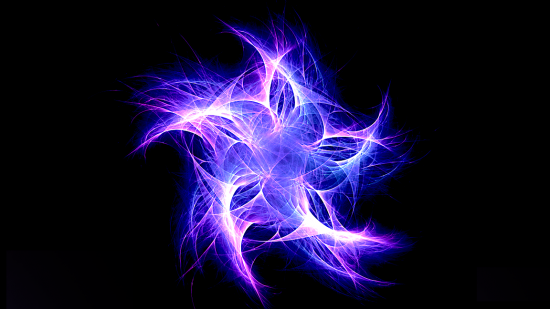
“Fractal Star” by Vectormediagr at DeviantArt
Apr 20, 2016
Ultraviolet light.
We have said much, up to this point, concerning the colors associated with the Saturnian planet and its god, and we shall have reason to say more. But, for the time being, it is enough to keep in mind that, in ancient literature, as we have found out, Saturn is not only described as blue and/or black but also as blue-black.1 This has caused much confusion among those who have tried their utmost to understand what the ancients were implying. Can we do better?
As we have pointed out in one of our prequels,2 the names we give to colors do not mean the same to everyone. Studies by the World Color Survey have shown that the evolution of color names, or lexicons, have changed over time in a complex manner.3
“English and many other languages spoken in industrialized societies include 11-12 basic color terms. In contrast, there is a great diversity in color terminology across languages spoken in preindustrialized cultures, with some languages using as few as two or three color terms, and other languages using more.”4
We could take ourselves on a long intricate journey through the ever branching maze of linguistic argumentation concerning this convoluted subject. Allow me instead to keep it short and simple by offering just two examples that are more in keeping with the subject at hand.
The very word “purple” which, according to the Oxford English Dictionary, did not enter the English language until A.D. 975, is ultimately derived from the Greek porphyra, which was used to describe the dye that was extracted from the shellfish which we now know as Murex purpurea. However, the word porphyra did not itself mean “purple” and, to be sure, the dye obtained from this mollusk has more of a reddish tint. So, likewise, in ancient Hebrew where “purple” is rendered argaman, derived from the Chaldean ‘argevan which does not mean “purple” but translates as “scarlet.”5 It all makes one think that the ancients did not originally have a word for purple and that dark blue, black, or blue-black was the closest they could come in describing the light that was shed by proto-Saturn’s flare-up. After all, dark blue and/or blue-black are not inapt descriptions for the color purple if a language has no word for that particular shade. This is not to say that the word “purple” is never used in ancient texts since, in the end, a word had to be invented to describe this divine color. And yet, do we not still refer to ultraviolet lamps and the glow they emit as black light?
We have said much in previous works concerning ultraviolet light, the way it affects life, together with the different hues it might be held responsible for.6 But most of that was in relation to other planets or to an Earth in ages long before the advent of mankind. So the question now arises:
Apart from the electrostatic discharges, oceanic incursions, ballistic impacts, incinerations, volcanic and tectonic tribulations, that beleaguered Earth and its inhabitants—how did our ancient forebears fare within the new milieu that was established in response to Earth’s irradiation of proto-Saturn’s ultraviolet light?
We have already discussed the wide-ranging epidemics that exterminated a substantial portion of Earth’s tribal populations through the cosmic rays dispelled by proto-Saturn’s flare-up. We can now say those rays included ultraviolet radiation. But that such radiation is not necessarily harmful under all conditions we have also previously discussed.7 Judging by clues left from the distant past, it is now known that there have been variations in ultraviolet radiation throughout Earth’s history, not all of which was harmful to primordial life.8
It is not only primordial life that, in certain cases, managed to survive what would normally be considered lethal doses of ultraviolet radiation. This was proven through an experiment that was conducted on NASA’s Long Duration Exposure Facility, a space satellite that was deployed in 1984. Some of the spores of the bacterial species known as Bacillus subtilis that were placed on the satellite were protected from solar ultraviolet light beneath a thin aluminum cover, while others were not. When, six years later, the satellite was retrieved, it was discovered that not all the spores that had been protected by the aluminum cover managed to survive, while not all those who were not so protected succumbed to ultraviolet light.9 It was thus determined that even within items as small as dust particles, ultraviolet radiation would not necessarily harm entire microbial colonies.10
Microbes, however, are not the only form of life that can survive ultraviolet radiation. Not only that, but, as the Chinese Academy of Agricultural Sciences demonstrated, ultraviolet radiation can be beneficial. This was proven through an experiment in which several one-day-old broiler chickens were randomly separated into two individual groups and placed in separate but identical coops. Both of the enclosures were illuminated by ordinary light, with ultraviolet radiation added to only one of them. Those chickens in the ultraviolet-radiated pen not only thrived, but their growth speed increased, their muscles improved, as so did the quality of their skeletal frame, the uniformity of their body, as well as their overall performance.11
There have been several other experiments showing both the harm and benefit of living beneath random doses of ultraviolet radiation. In the end, however, none of these studies can really tell us how it was that those who survived the catastrophes unleashed 10,000 years ago by proto-Saturn’s flare-up managed to cope beneath the ultraviolet radiation that continued to stream down on Earth for an undetermined, but long, period of time. As we shall be indicating in a future volume, long after the dust settled and the sky regained its clarity, the purple star continued shining in the north.
Extracted from Chapter 12 of Metamorphic Star, one of the reconstruction books by Dwardu Cardona.












